Digikam/Tour/da: Difference between revisions
Importing a new version from external source |
Importing a new version from external source |
||
| Line 47: | Line 47: | ||
==Niveauer== | ==Niveauer== | ||
Lad os først bruge niveauredskabet, som findes under <menuchoice>Farve -> Justering af niveauer</menuchoice>. | |||
[[Image:Digikam_01_levels.jpeg|250px|thumb|center]] | [[Image:Digikam_01_levels.jpeg|250px|thumb|center]] | ||
Revision as of 06:24, 11 January 2011
Introduktion
Hvis du dyrker digitalfotografering seriøst, så er du nok fortrolig med softwareprodukter fra firmaer som Adobe™, Corel™, ACD Systems™, Bibble Labs™, Light Crafts™ og Google™. Du har måske også prøvet Gimp'en, som indtil for nyligt var den vigtigste open source-fotoeditor. Desværre mangler Gimp'en en funktion, som er meget vigtig for fotografer, nemlig evnen til at redigere med 16 bit per kanal. Af den grund tager de fleste seriøse fotografer ikke Gimp'en alvorligt som et alternativ. Ganske vist er der Cinepaint, som skilte sig ud fra Gimp'en for et par år siden, og den har 16 bit per kanal-redigering. Desværre er dens brugerflade mangelfuld og det vikrer ikke som om den bliver vedligeholdt særlig meget.
Heldigvis er der nu et andet open source-alternativ, som kan redigere i 16 bit mode - digiKam, som virker klar til at give de store drenge konkurrence. Jeg har selv først for nylig opdaget digiKam - det vil sige: jeg har prøvet den før, men først nu i dens KDE SC 4 udgave synes jeg, at den kan klare mine behov. Jeg blev faktisk ret overrasket over, hvor meget den er blevet forbedret og hvor mange nye funktioner der er inkluderet i den. Her er nogle hovedpunkter:
- understøtter 16 bit per kanal.
- Redskaber til kurver og niveauer.
- Understøtter farvehåndtering.
- Hvidbalance-redskab med farvevælger.
- Redskaber til linsekorrektioner.
- Beskæringsredskab som understøtter givne sideforhold med adskillige
standardformater til rådighed.
- Redskab til konvertering til rigtige sort-hvid billeder
- Automatiseret behandling
- Funktioner til mærkning og søgning
- Eksport til Facebook, Flickr, Picasa etc.
Og der er meget, meget mere, som jeg bare ikke har tid til at komme ind på. Selvfølgelig er digiKam ikke perfekt; og der er et par ting, som jeg formoder vil blive forbedret eller rettet snart; men jeg kan forsikre dig, at hvis du interesserer dig for fotografering, så kommer du til at høre meget mere til digiKam i fremtiden, og forhåbentlig vil du også få glæde at den.
Lad mig nu give dig en hurtig fremvisning af, hvordan det er at arbejde i digiKam. Jeg bruger i øjeblikket digiKam version 1.0.0-beta4 fra PCLinuxOS-arkiverne.
RAW redigering
Til denne fremvisning har jeg valgt følgende billede, fordi dets belysning er udfordrende.
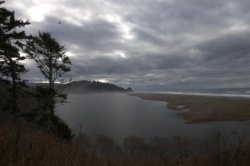
Dette er et billed i RAW-format taget med mit gamle Pentax istDS*. Sådan ser det ud i digiKam's editor, som forøvrigt også findes som en selvstændig applikation ved navn ShowFoto.
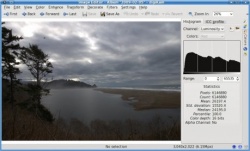
Hvis du er fortrolig med histogrammer, så har du måske bemærket, at histogrammet i dette billede ser ret mærkeligt ud. Årsagen er, at digiKam kan vise to slags histogrammer, lineære og logaritmiske. Det vi ser her er et logaritmisk histogram, men de fleste er vant til lineære histogrammer. Man kan skifte mellem histogramtyper ved at klikke på deres respektive lille knap oven over histogrammet. Hvis jeg klikker på den lineære histogram-knap for dette billede, så får jeg desværre en flad linje. Her er, hvad digiKam's dokumentation har at sige om dette:
“for billeder, som indeholder store områder med den samme farve, vil et lineært histogram ofte være domineret af en enkelt søjle. I det tilfælde vil et logaritmisk histogram ofte være mere brugbart.”
Jeg er sikker på, at der er tekniske grunde til dette, men jeg undrer mig over, at andre programmer, som Cinepaint, udemærket kan vise et lineært histogram for dette billede. Jeg nævner dette fordi jeg ved, at der er nogle, som har meget brug for histogrammer, og jeg mener at den lineære type er mest brugbar. Men et logaritmisk histogram er selvfølgelig bedre end ingenting. Dette er ikke en afgørende ting for mig, så lad os gå videre.
Jeg er endnu ikke en ekspert i efterbehandling. Min normale arbejdsgang, når jeg redigerer et billede er at redigere niveauerne, justere mætningen, beskære eller ændre størrelse og gøre billedet skarpere. Lad os derfor prøve at gøre det med dette billede.
Niveauer
Lad os først bruge niveauredskabet, som findes under .
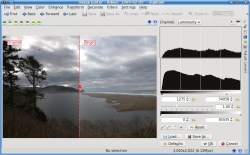
I basically just added a bit of contrast by moving the left lever (below the second histogram) to the right and lighten the image by moving the right lever to the left. The preview window adjusts automatically as I make my adjustments so that I know what the result will be.
Saturation
Now, lets increase the saturation to try to bring out the color a little. For that we use the saturation tool found under .
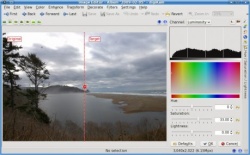
I don’t like the “Disney” look that some point and shoot cameras default to with supper saturated colors. I like to keep my images somewhat realistic looking. So I don’t like to bump the saturation too much. I feel that, for this picture, that amount of saturation is just enough to give it a bit of life without going too far into cartoon land.
Cropping
Now I am going to crop the image. This is really an important step if you are planning on printing the image. If you have ever taken your DSLR images to be printed without cropping them first, you may have been unpleasantly surprised by the fact that they were not centered correctly, or that an important part of the image was left out. The reason for this is that the image you gave them did not have the same proportions as the paper you asked them to print it on. And so they had to crop it for you. To prevent that from happening you need to crop your images to the same proportions of the paper you will be printing on. Yes, that means that you will need a different image if you want to print 8×10 than if you want 5×7, 14×20, etc. Fortunately, digiKam makes this step a breeze with its aspect ratio crop tool found under .
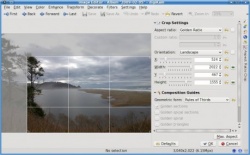
As you can see I chose to use the “Golden Ratio” option for this image, but digiKam has predefined settings for all the common printing paper ratios in the market and even allows you to choose a custom ratio if you desire.
Sharpening
The final step in my photo processing work-flow is to sharpen the image. I am used to using the method for this purpose, but in reading digiKam’s documentation I was surprised to learn that they actually recommend the method as a way to obtain better results. This is how the Sharpen tool looks, found under .
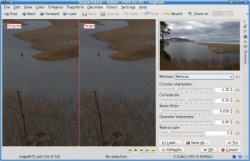
As you can see, you can change the sharpening method used with a drop down button. You can zoom in to the image as much as you want using the button, and you can move the zoom window around in the small preview image above the settings area. I was conservative in the amount of Circular sharpness specified because I could see in the preview area that going for more would result in a lot of grain being visible. This amount improved the sharpness significantly while still retaining the smooth look of the overall image. This is my final result.
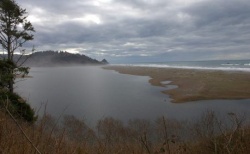
As you can see, there is quite a bit of improvement over what we started with.
Auto-Correction
Normally I would have been content with leaving it at that. But since I am still in the exploring digiKam mode, I decided to test some of the tools available. To do that, I went back to the original RAW image, and after importing it, I went straight into . This is what it looks like.
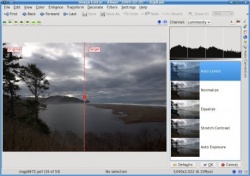
As you can see, there are five automatic correction levels that you can choose from to improve your image. In most images that I have tried this with, the option gives the best results. However, in this particular image the result was too dark. I had not seen any image for which the option resulted in an improvement, but for this particular image the results it gave me were surprisingly good. This is what the digiKam documentation says about the method of :
"Equalize: this method adjusts the brightness of colors across the selected image so that the histogram for the Value channel is as flat as possible, that is, so that each possible brightness value appears at about the same number of pixels as each other value. Sometimes Equalize works wonderfully at enhancing the contrasts of an image. Other times it gives garbage. It is a very powerful operation, which can either work miracles on a image or destroy it."
Well, looks like they were not kidding. My image turned out much better using this method of correction instead of my normal level adjustment step. This is how the image looks after adding saturation, cropping it, and sharpening it.
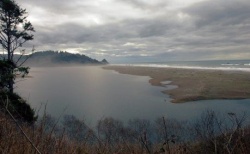
Conclusion
Without a doubt digiKam has a lot to offer for the photographers among us. Unfortunately, it still has one glaring omission – a clone tool. You may have noticed that the original RAW image had some dust specks in the sky above the trees and in other parts of the clouds. In digiKam, the only tool available for trying to remove such things (other than cropping them out as I did here) is a tool called , found under . However, that tool is not easy to use and is rather slow. With a proper clone tool, as available in most other photo editors, removing such items only takes a few seconds. The good news is that the digiKam developers have acknowledged this omission as a bug and we can expect to see it implemented in a future version of digiKam. In the mean time we can use the Gimp to take care of these items as a final touch up step.
I think you will agree that digiKam is an amazing open source tool. It has now become my main photo editor. If you are into photography, why not give it a try?
This page was written in October 2009. Can you add to it, talking about a later version?

